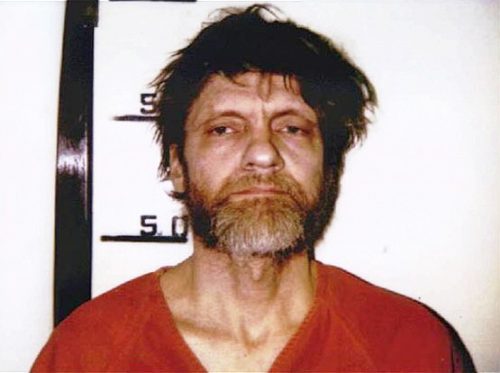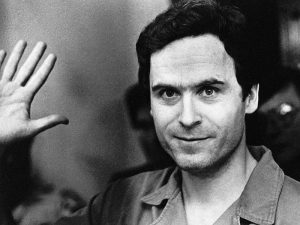Theodore “Ted” Kaczynski, nicknamed the “Unabomber,” killed and injured several people from 1978 to 1995 using mail bombs. Many experts on terrorism have difficulty in establishing whether to consider Ted a terrorist. Some believe he is simply a murderer, while others say that because of his political agenda and his decision to go after certain kinds of people, like science professors and big businessmen, that he should indeed be classified as a terrorist.1
Years before his bombing spree, in 1958, Kaczynski had been a student at Harvard University. The most astounding part is that he was only sixteen years old when he attended his first year as a freshman in college. As a child, Ted had been deemed a gifted student by his teachers. He reportedly had an IQ of 157 at the age of ten. He was allowed to skip sixth grade and work with older students, but he did not like that at all. In his journal, Ted described working with older students as considerably difficult, and he was regularly taunted by them. He never seemed to fit in. During high school, his struggle to be social continued, and he felt isolated from the rest of the students. Despite all of these problems, he still excelled academically and was allowed to skip the eleventh grade. He did have a moment of social fame which came when he made a pipe bomb in one of his science classes, but that moment of fame soon died away and he was alone again.2
During his time at Harvard, Ted continued to have extreme success academically, but still failed to be a part of the college’s social life. He lived in a single room, and some of his classmates recalled the room as messy, and that Kaczynski hardly had any interaction with any of his peers. At Harvard, he joined a study to determine the effects of extreme stress on the human psyche. The study had participants undergo extreme interrogations and personal belittlement over their beliefs and ideals. These interrogations upset Kaczynski, and he began to feel a disdain towards society and authority. According to Alston Chase, a Kaczynski researcher, Ted began to develop a theory to explain his anger and unhappiness. Chase said that, in Ted’s eyes, science and technology were destroying liberty and nature. The “system,” which included Harvard, sought to transform men into automatons to serve the machine by using techniques of behavior modification like propaganda and advertising. Unknowingly, during his undergraduate career, Ted was well on his way to becoming the Unabomber. He completed his undergraduate degree in mathematics in 1962, and went on to graduate school at the University of Michigan. He earned his master’s and Ph.D. in mathematics, and professors often described him as ambitious and talented.3
At that time, the University of California at Berkeley was considered the center of the counterculture movement, and that is where Ted decided to begin his career as a professor. He was uninterested in political activism, and failed, yet again, to become involved with those around him. He didn’t really have the talent to be a teacher and was very unpopular with students. So in January of 1969, he decided to resign his position at the end of the term. He also intended to give up mathematics altogether. His professional and social life began to spiral down after the decisions he had made.4

After his resignation, Kaczynski returned to Illinois, which was where he was born, and lived in a house owned by his parents. He was unemployed, and worked random jobs to get money, as well as borrowing money from his parents. Kaczynski was living as a hermit in the 1970s, and had little interaction with people as he began to sink deeper into his social isolation and anger. He directed all of that anger towards technology and its advancements in society. He began to write about the evils that came with technology and its control over individuals.5 During his time as a hermit, Ted decided to move to Montana where his brother lived. They split the cost of an open piece of land near Lincoln, Montana, and he began to construct a rudimentary cabin that measured 10 by 12 feet and lacked running water, electricity, and heat. Some of his neighbors described him as a quiet man who rode his homemade bicycle and spent a lot of time at the library. He enjoyed reading, and he acquired a substantial collection of volumes that filled his little home. As the decade progressed, he became more and more isolated from society. He returned to Illinois in 1978 and worked at a foam rubber factory where his brother was a supervisor. He was fired by his brother just a few weeks later, after posting insulting limericks around the factory because he had been rejected by a female plant manager. Many believe that this event was the tipping point that began his bombing campaign.6
Ted Kaczynski’s lengthy bombing campaign began on May 25, 1978, when he sent out his first bomb to Northwestern University. The box containing the bomb had a return address with the name of Professor Buckley Crist. The professor was suspicious of receiving a package that she never sent out and asked a campus officer to open it. The bomb detonated and caused the officer minor injuries. Ted then continued his campaign by attempting to bomb an airplane in November of 1979. The bomb detonated in the cargo hold and forced the place to land immediately. This attack sparked the start of a major investigation codenamed “Unabom” because of the university-based targets and the attack on a United Airlines executive.7

Throughout the span of seventeen years, the Unabomber seriously injured more than twenty-two people and killed three. One of the most notable deadly bombings was that of Gilbert Murray, a California timber-industry lobbyist. The package arrived on Monday, April 20. The first person to come in contact with the shoebox-size package was the receptionist who had trouble opening the package and carried it to her boss’ desk. At this point in Kaczynski’s bombing campaign, he had developed much more powerful and deadlier bombs that his previous ones. As Murray started to unwrap the package, it blew up in his hands. The blast killed Murray, forty-seven years old, and was so powerful it knocked two doors off their hinges and blew gashes into the ceiling panels. It was also loud enough that people heard it for blocks around. This startled and scared many people because the Oklahoma City bombing had occurred only five days earlier.8 It turns out that the bomb was never intended to kill Gilbert Murray but instead his predecessor, William Dennison. Dennison was the chief lobbyist for the forest-products trade group from 1980 to 1994 and a highly visible figure in a number of environmental issues. He was replaced by Murray who was killed by a package addressed to Dennison. At that time, William Dennison was seen as the No. 1 person in the timber industry because he was a prominent voice in the Pacific Northwest during the “the timber wars,” which involved environmentalists going up against ranchers, loggers, and the timber industry. Dennison was a key figure in the timber industry and many, including Ted, saw him as a threat to the environment, which could have been a reason why the Unabomber chose him, specifically.9

Around the time of the attack that killed Gilbert Murray, the Unabomber sent a letter to different newspapers, including the New York Times, that offered to stop his bombing spree if they published a manuscript titled “Industrial Society and Its Future,” which would later be known as the “Unabomber Manifesto.” If they did not comply, he threatened that the Freedom Club—”FC” was engraved on all his bombs—would ramp up their terrorist campaign. The manifesto ended up getting published by the Washington Post with help from Time Magazine on September 19, 1995. David Kaczynski, Ted’s brother, read the manifesto and recognized his brother’s writing style from reading unfinished copies that Ted had in his cabin. David contacted the authorities and Ted Kaczynski was arrested in April of 1996 in Montana. In his cabin, they found more than enough evidence, which included bomb-making supplies and early versions of the manifesto, to prove Kaczynski guilty. Two months later, he was charged with several criminal counts relating to the production and distribution of mail bombs. He resisted his lawyers’ efforts of declaring him insane and ended up not being able to represent himself in court. He agreed to a plea deal in 1998 to avoid going to trial. He pled guilty and was sentenced to life in prison without parole, and is still currently serving his sentence.10
- The Greenhaven Encyclopedia of Terrorism, 2007, s.v. “Unabomber, the (1942),” by Patricia D. Netzley. ↵
- Salem Press Encyclopedia of Science, 2013, s.v. “Unabomber case,” by Brion Sever. ↵
- Encyclopedia of World Biography, 2013, s.v. “Ted Kaczynski.” ↵
- Encyclopedia of World Biography, 2013, s.v. “Ted Kaczynski.” ↵
- Salem Press Encyclopedia of Science, 2013, s.v. “Unabomber case,” by Brion Sever. ↵
- Encyclopedia of World Biography, 2013, s.v. “Ted Kaczynski.” ↵
- Salem Press Encyclopedia of Science, 2014, s.v. “Unabomber” by Steve Hewitt. ↵
- Michael Lemonick and Jordan Bontante, “The bomb is in the mail,” Time, May 8, 1995, http://content.time.com/time/magazine/article/0,9171,982900,00.html. ↵
- Kenneth B. Noble, “Bombing in Sacramento: The Investigation; Bomb Meant for Predecessor Of Victim, Officials Say,” The New York Times, April 26, 1995, https://www.nytimes.com/1995/04/26/us/bombing-sacramento-investigation-bomb-meant-for-predecessor-victim-officials-say.html. ↵
- Encyclopedia of World Biography, 2013, s.v. “Ted Kaczynski.” ↵



111 comments
Emilia Caballero Carmona
Hey Pedro, I enjoyed reading your article because I had recently watched the show on netflix about the Unabomber and how the police got to him. It is so surprising to see that back then the mail system in the United States didn’t have a scanning system to detect dangerous packages. It’s a shame that Ted used his intelligence and incredible skills to commit these horrible crimes, instead of using them for a good purpose.
Aaron Sandoval
This article was well written and covered many key parts of Kaczynski’s life. You did a good job of covering his life that led to his war against technological advances. I noticed that a lot of people were shocked to learn that he was so smart, and I personally am not as shocked. Kaczynski was a man on a mission and wanted the world to know what he was thinking, that’s why he wanted to his manifesto published, and I think this article covered that well.
Aracely Beltran
Great article! It is so crazy how such a smart guy threw everything away. He had what in his hands what a lot of people dream of and it all went down the drain. He should have used his intelligence and anger towards something good and beneficial to society. Instead, he bombed people without a motive, he did not even have an actual target. Sad.
Melanie Fraire
This was my first time ever hearing about the “Unabomber” but I definitely found it interesting since he had so much potential with how intelligent he was, he could’ve done so much more than what he became which is a shame. However I can’t imagine the fear he caused all those years to innocent people receiving packages, he truly caused a lot of damage and could’ve caused even more if it weren’t for his brother turning him in.
Andrea Degollado
I think it’s truly sad to read how much potential and how smart Ted was, and the way he decided to use his intelligence was to harm others. I believe that what drove Ted to do these things was that he had a resentment to what his intelligence brought to him, which was that he felt like an outsider like a loner. I think that it was extremely wowing that as a sixteen year old he was attending university, Harvard university, for that matter. Very interesting article!
Kimberly Parker
I was very surprised that he had gone to college at the age of 16, even more so to find out that he went to Harvard. I mean, he was so smart, gifted even, and he chose to use everything that he had learned and knew, to do bad things instead of using it all to help improve the world and that is just so disappointing. He killed and injured dozens of people with his actions, and there is nothing that anyone can say that could ever excuse what he had done.
Mara Martinez
I have heard many things about the unabomber, but I never really knew about his past so this article was very interesting in getting to read how Ted was really “created” into the unabomber and how he started to slowly take the downward spiral into a killer. Super super interesting article and good read.
Michael Lazcano
It’s really fascinating to see that such a bright and intelligent man, turned to such violence when his talents could have been used elsewhere. I wonder if there were any other warning signs that he would be prone to such actions, we talk about this today in the era of school shootings but back then it wasn’t. He didn’t bomb to just bomb, he had a manifesto, or a message he wanted spread and I think that separated him from other terrorists we know today. His social isolation was the big turning point in his life and I think if life did go his way that we would be seeing his name in a more charming light, rather than as a killer
Shea Slusser
Considering this man was so smart he could skip two grades and attend Harvard as a 16 year old, its very unfortunate that such knowledge was used toward such tragic behavior. I don’t think its very clear if this was a terrorist attack or not, but either way, this man killed and injured dozens of people, and there is no excuse for his actions. I’m glad we caught him before anymore destruction, and life in prison sounds like a good sentence to me.
Saira Locke
Clearly Theodore Kaczynski is a very intelligent man. He was able to skip two different grade levels due to his advance knowledge. He was also able to attend Harvard University at the young age of 16. Though, not all intelligent people are good people. Ted Kaczynski was a murderer and can possibly be characterized as a terrorist. It is very unbelievable and sad that mail bombings are even successfully possible. I believe that special precautions should be done to detect these types of packages and prevent this from ever happening again. It is very likely that some individuals will try to recreate his crimes due to fascinations. I give props to Tod’s brother David Kaczynski for turning Tod in. Although a betrayal to Tod, David saved many lives for being brave and having a good heart.